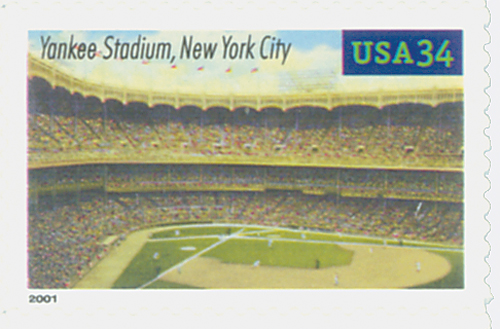
# 3513 - 2001 34c Legendary Baseball Fields: Yankee Stadium
34¢ Yankee Stadium
Baseball’s Legendary Playing Fields
City: New York, NY, Boston, MA, Chicago, IL, or Detroit, MI
Quantity: 125,000,000
Printed by: Avery Dennison
Printing Method: Photogravure
Perforations: Serpentine Die Cut 11.25 x 11.5
Color: Multicolor
Opening Of Original Yankee Stadium
The New York Yankees trace their roots back to 1901. They were one of several teams created in the American League to challenge the National League. Though the team’s creators wanted to be based in New York, the National League’s New York Giants had strong political connections that prevented that from happening. So instead, the new team was stationed in Baltimore, Maryland, and called the Orioles.
Then in 1903 the team found a way to move to New York. So they opened Hilltop Park and became known as the Highlanders. It was during this era that the team was first unofficially referred to as the Yankees.
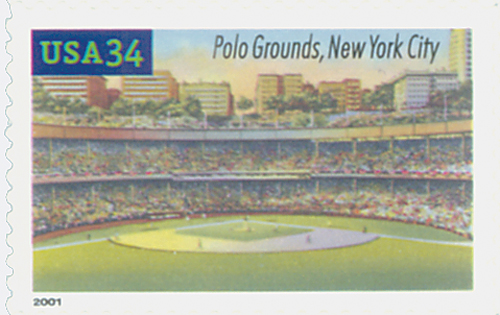
Then in 1911 the Giants’ stadium, the Polo Grounds, burned down, and they were invited to play at Hilltop Park while their park was being rebuilt. Relations between the two teams improved and the Highlanders were then allowed to play at the Polo Grounds. Because they were no longer based at Hilltop Park, the team adopted their nickname as their official name, becoming the New York Yankees.
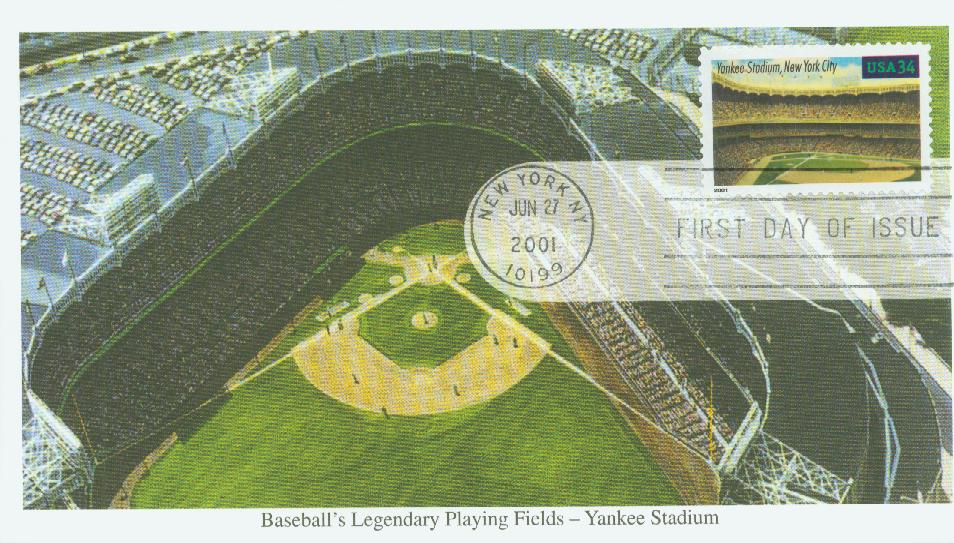
Relations between the two teams then began to falter in 1920 after the Yankees acquired Babe Ruth. Soon more fans came out to see the Yankees than the Giants. Then the Giants told the Yankees to find their own park. So the Yankee’s owners agreed and decided to build their own stadium. They considered several possible sites, including one in Manhattan, but ultimately decided on a 10-acre lumberyard in the Bronx. Commenting on their new location, the Giants’ manager claimed that, “Before long they will be lost sight of. A New York team should be based on Manhattan Island.”
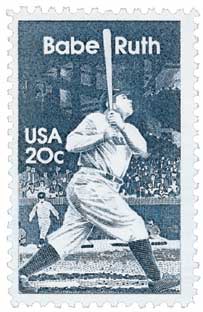
The owners paid $600,000 (about $8.58 million today) for the land and $2.5 million ($120 million) for the stadium itself. The owners also took a risk in the stadium’s size. Most baseball parks from the era seated about 30,000 people. But they believed that Ruth’s popularity would draw far more than that, and opted for a 60,000-seat park. Construction began on May 5, 1922 and would be completed in less than a year. The stadium’s walls were reportedly built from a durable concrete developed by Thomas Edison.
Yankee Stadium officially opened for business on April 18, 1923. That day would be their first home game of the season against the Boston Red Sox. Before the game began, John Philip Sousa led the Seventh Regiment Band down the field while playing The Star-Spangled Banner. The players and several dignitaries then paraded across the field before Babe Ruth was presented with an oversized bat. New York Governor Al Smith threw out the ceremonial first pitch and then the game began about 3:35 pm.
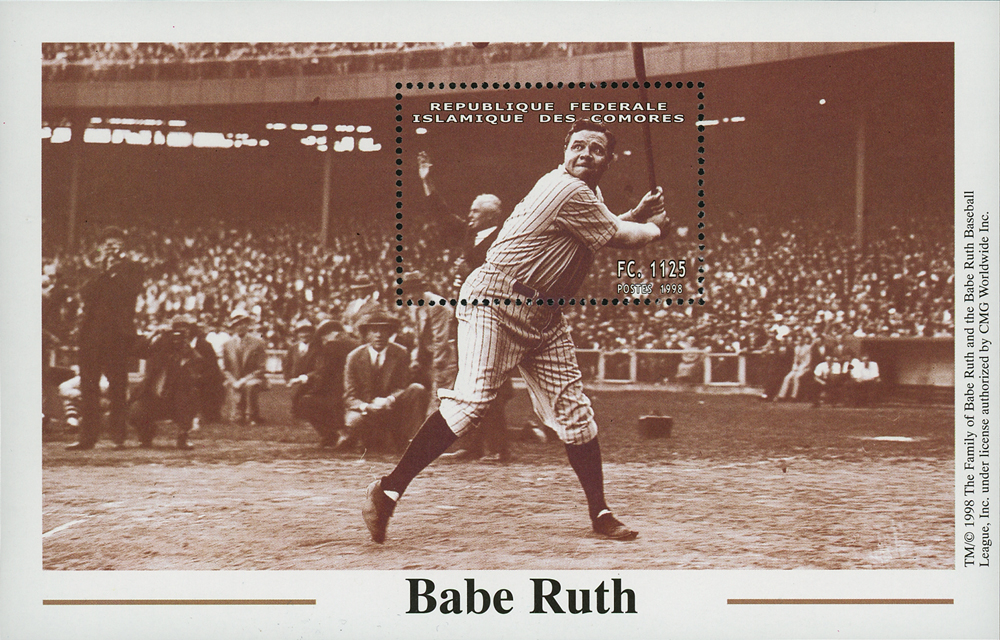
In the bottom of the third inning, Babe Ruth hit a three-run home run, the first in the new stadium. The New York Times described it as “a savage home run that was the real baptism of Yankee Stadium.” The Yankees went on to win the game 4 to 1.
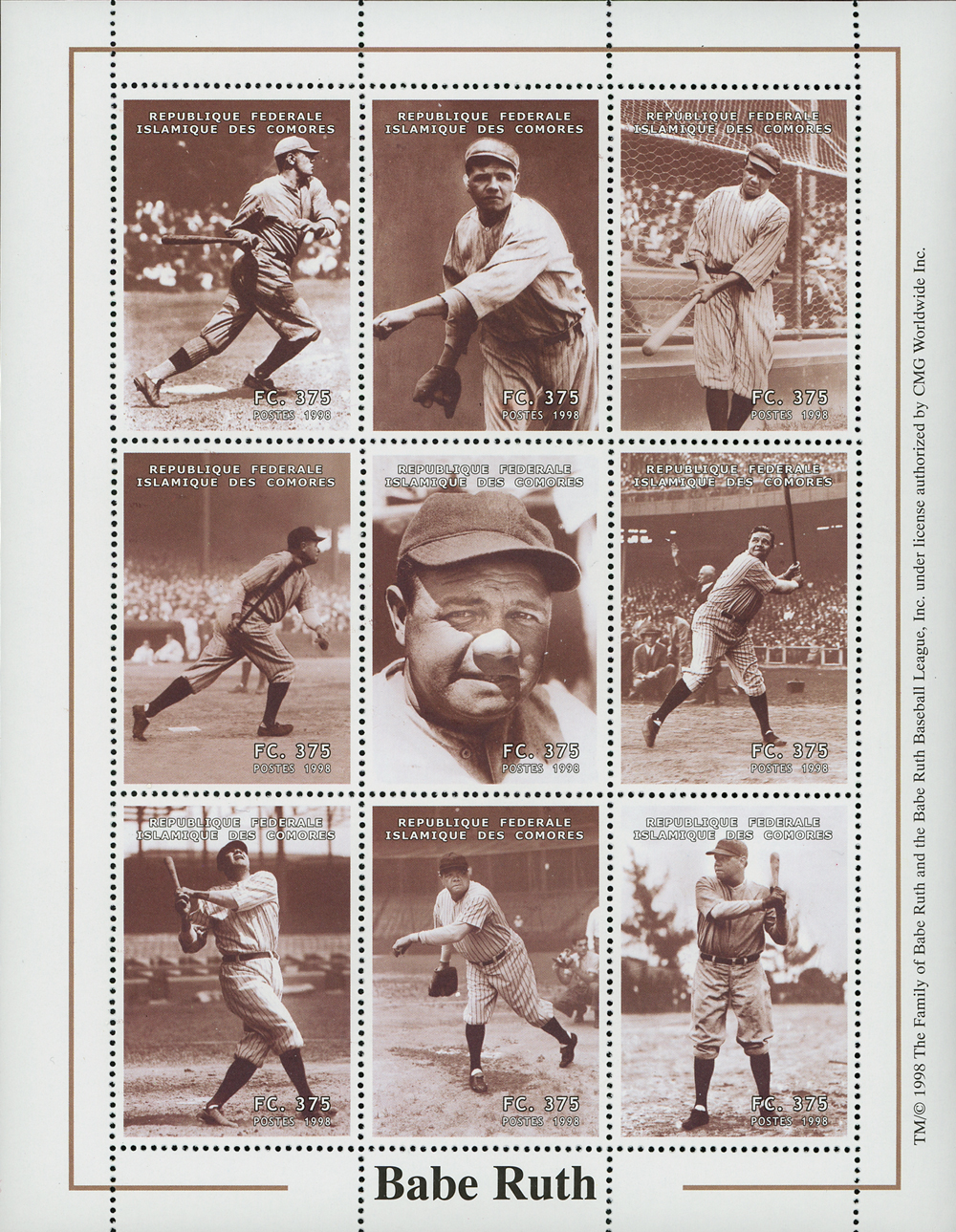
Initially, it was claimed that there were 74,217 people in attendance for that first game, but it was later revealed to be 60,000. Additionally, 25,000 people were turned away because there wasn’t room, but many remained outside the stadium to listen to the game. The New York Evening Telegram was the first called the new stadium “The House that Ruth Built” in its coverage of that first game. The Yankees went on to win their first World Series later in the year against their rivals, the Giants.
Click here for a neat video about Yankee Stadium
34¢ Yankee Stadium
Baseball’s Legendary Playing Fields
City: New York, NY, Boston, MA, Chicago, IL, or Detroit, MI
Quantity: 125,000,000
Printed by: Avery Dennison
Printing Method: Photogravure
Perforations: Serpentine Die Cut 11.25 x 11.5
Color: Multicolor
Opening Of Original Yankee Stadium
The New York Yankees trace their roots back to 1901. They were one of several teams created in the American League to challenge the National League. Though the team’s creators wanted to be based in New York, the National League’s New York Giants had strong political connections that prevented that from happening. So instead, the new team was stationed in Baltimore, Maryland, and called the Orioles.
Then in 1903 the team found a way to move to New York. So they opened Hilltop Park and became known as the Highlanders. It was during this era that the team was first unofficially referred to as the Yankees.

Then in 1911 the Giants’ stadium, the Polo Grounds, burned down, and they were invited to play at Hilltop Park while their park was being rebuilt. Relations between the two teams improved and the Highlanders were then allowed to play at the Polo Grounds. Because they were no longer based at Hilltop Park, the team adopted their nickname as their official name, becoming the New York Yankees.

Relations between the two teams then began to falter in 1920 after the Yankees acquired Babe Ruth. Soon more fans came out to see the Yankees than the Giants. Then the Giants told the Yankees to find their own park. So the Yankee’s owners agreed and decided to build their own stadium. They considered several possible sites, including one in Manhattan, but ultimately decided on a 10-acre lumberyard in the Bronx. Commenting on their new location, the Giants’ manager claimed that, “Before long they will be lost sight of. A New York team should be based on Manhattan Island.”

The owners paid $600,000 (about $8.58 million today) for the land and $2.5 million ($120 million) for the stadium itself. The owners also took a risk in the stadium’s size. Most baseball parks from the era seated about 30,000 people. But they believed that Ruth’s popularity would draw far more than that, and opted for a 60,000-seat park. Construction began on May 5, 1922 and would be completed in less than a year. The stadium’s walls were reportedly built from a durable concrete developed by Thomas Edison.
Yankee Stadium officially opened for business on April 18, 1923. That day would be their first home game of the season against the Boston Red Sox. Before the game began, John Philip Sousa led the Seventh Regiment Band down the field while playing The Star-Spangled Banner. The players and several dignitaries then paraded across the field before Babe Ruth was presented with an oversized bat. New York Governor Al Smith threw out the ceremonial first pitch and then the game began about 3:35 pm.

In the bottom of the third inning, Babe Ruth hit a three-run home run, the first in the new stadium. The New York Times described it as “a savage home run that was the real baptism of Yankee Stadium.” The Yankees went on to win the game 4 to 1.

Initially, it was claimed that there were 74,217 people in attendance for that first game, but it was later revealed to be 60,000. Additionally, 25,000 people were turned away because there wasn’t room, but many remained outside the stadium to listen to the game. The New York Evening Telegram was the first called the new stadium “The House that Ruth Built” in its coverage of that first game. The Yankees went on to win their first World Series later in the year against their rivals, the Giants.
Click here for a neat video about Yankee Stadium






